Water Accounting in Use webinars | 2020
Summary of Water Accounting Webinar Series Part 2: “Implementing the 2030 Agenda for water efficiency/productivity and water sustainability in NENA countries” (2020)
This Webinar Series Part 2 is provided as part of the activities of a project at the FAO Near East and North Africa (NENA) Regional Office called “Implementing the 2030 Agenda for water efficiency/productivity and water sustainability in NENA countries”. This training is the continuation of the Water Accounting (WA) Webinar Series Part 1 that took place in 2019. The target participants are those who produce, analyze, and interpret water accounting outputs. Also, some of the webinars will be useful for decision makers in the field of water resources management and agriculture. Though the contents are designed for stakeholders of the above-mentioned project, this training is open to the public and free of charge for anyone who are interested in the topics. Completion of the Webinar Series Part 1 is not mandatory but is highly recommended as this Webinar Series Part 2 assumes the participants have basic understandings of water accounting -concepts and approaches. The learning goals of this training are to learn Methods/tools/analyses that may be used in water accounting and Water Auditing (water governance assessment) that is implemented alongside water accounting. These materials will be supported with examples of issues/problems that water accounting can inform and case studies of problem-targeted water accounting from different countries. This training consists of 16 webinars presented by speakers from various institutions, online quizzes, and a final training evaluation.
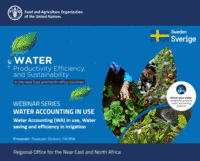
Webinar 1 Summary: Water Accounting (WA) in use, Water saving and efficiency in irrigation
In this Webinar, Dr. Pasquale Steduto (Senior Water Advisor, FAORNE) starts with a brief overview on the definition of WA and its relationship with sustainability. Illustrative examples were provided to explain the concepts of water saving and efficiency in comparison to financial and energy saving and efficiency. He explained that water uses can be classified into consumption and return flow, and return flow can be further classified into recoverable and non-recoverable fractions. He explained that we can save water from reduction of the consumption and non-recoverable return flows. In other words reduction of recoverable return flows is not a water saving. This is finalized with an explanation of how irrigation efficiency improvement does not equate to water saving supported by cases from Spain, Egypt, Iran, and the United States.
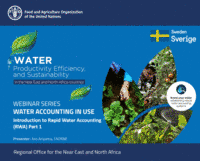
Webinar 2 Summary: Introduction to Rapid Water Accounting (RWA) Part 1
In this Webinar, Jiro Ariyama (FAO Regional Office for Near East and North Africa) provides a background on what is RWA, preparatory steps to take in RWA such as identifications of key questions, stakeholders, spatial and temporary boundary of the study. The different spatial and temporal scales and their relations with key questions are explained. In addition, the suggested contents of RWA are described that includes important considerations such as the level the detail and the data sources. The Resource Infrastructure Demand Access (RIDA) framework and perceptual diagram. The webinar is finalized with a review of different categories of water uses and pathways and examples on how a use/pathway can be categorized differently in farm and basin scale analysis.
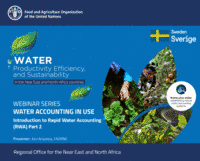
Webinar 3 Summary: Introduction to Rapid Water Accounting (RWA) Part 2
In this Webinar, Jiro Ariyama (FAO Regional Office for Near East and North Africa) continues from the preceding webinar by introducing the concept of the water budget and conducting exercise with the participants. The reasons why water budgets are developed as well as the common errors and challenges associated with it are explained. A case study from Sacramento (California, USA) is also given to demonstrate comparisons between water inflow and outflow. Finally, a guide on uncertainty assessment is provided that includes the importance of the level of uncertainties as well as feasibility to reduce the uncertainties.

Webinar 4 Summary: Water Productivity: concepts and assessment
In this webinar, Elias Fereres (Professor, University of Cordoba) begins the webinar with general global trend in water resources development for agriculture and in increasing irrigated area in contrast with decreasing water allocated for irrigation. He defines water productivity (WP) as production per unit water input and provides variations of water productivity expressed from different scales and perspectives such as biophysical and economic WPs. This is further explained by introducing the concepts of marginal water productivity (derivative of Yield-ET line) and how it can be used to find optimum WP value for some crops. Moreover, the equation of the water productivity gap is mentioned in addition to the methods of acquiring the components of the equation such as potential yield, actual yield, potential consumptive use, actual consumptive use. This is followed by an introduction into the different models used to determine water productivity in addition to the challenges of variability and uncertainty that such models experience. This is concluded with the applications of remote sensing on water productivity.
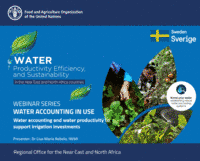
Webinar 5 Summary: Water accounting and water productivity to support irrigation investments
In this webinar, Dr Lisa-Maria Rebelo (Principal Researcher International Water Management Institute [IWMI]) introduces the origins of research on water accounting and agricultural water productivity at IWMI. A recap on commonly used definitions of agricultural water productivity and water accounting in IWMI context are given. This is followed with the key steps on WA+ of basin water balance calculations. A case study from Lao P.D.R is presented to show how water accounting and water productivity assessment were used for prioritizations of irrigation investments. This observing key indicators of water accounts and analyzing involves evapotranspiration, transpiration, yield, and water productivity. She concluded with the final key messages derived from the case study such as that water resource assessments are required at different scales to understand resource availability and sustainable levels of use.

Webinar 6 Summary: Water auditing. Definition and method
In this webinar, Dubravka Bojic (FAO) introduces the concept of water auditing (or water governance analysis) by defining it and its contribution to water governance. The values added by water auditing are 1) connect biophysical and technical information with institutional, socio-economic and cultural aspects and changes required 2) provide the basis for developing interventions that have more chances to be implemented. This is followed by an explanation of water governance analysis with regard to water accounting and how it is carried out in phases. The four-phase process of governance analysis is explained in detail for each phase that involves: identifying and characterizing problems, identifying key institutional challenges, identifying political economic factors behind key challenges, and developing programmatic priorities for action. The webinar is concluded with a quiz to test the acquired knowledge of the audience.

Webinar 7 Summary: Water auditing exercise
In this webinar, Dubravka Bojic (FAO) defines water auditing and explains that it is related to water governance by formal and informal rules, organizations & processes through which public and private actors articulate their interests, frame and prioritize issues, and make & implement decisions related to water resources. A quick recap on the value of water auditing is made. This is followed with water auditing activities with the participants. This incorporated a plenary discussion to identifying and frame the key problem of the case study explored, this is followed with breakout rooms that involve institutional and political economy analysis. This was finalized with a plenary to develop programmatic priorities for action.
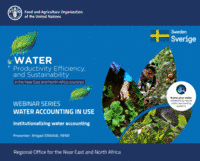
Webinar 8 Summary: Institutionalizing water accounting
In this webinar, Dr Amgad Elmahdi (Head of Middle East North Africa (MENA) Region, IWMI) introduces IWMI and the activities it carries out with regard to the challenges of water scarcity. The definition of water accounting is also provided in addition to why it is needed. The importance of multi-scalar analysis is described as it is essential for water accounting to be applied in the spatial domain. He presents the water accounting reporting system framework which includes the water accounting tools, line items, and reporting as well as elements. This is followed with a roadmap that describes tailored water accounting institutionalizing that involves several components such as data requirements and sources, existing policies and plans. Thought provoking water policy questions are given followed by water accounting data sources and key potential users of information. This is summarized with an illustrative example from Australia’s water accounting experience in terms of the need for data to be more institutionalized and empowering the water managers and users as well as stressing the need for investments.

Webinar 9 Summary: Water Accounting Team and Reporting Framework
In this Webinar, Dr. Amgad Elmahdi (Head of MENA Region, IWMI) quickly reviews definition of WA, its purposes, need for multi-scalar analysis water policy questions, WA reporting system framework, and WA elements. The joint functions of water accounting team such as discussing the key components of the regions and identifying the key data required & its sources are mentioned. Different roles in water accounting team, including producers (collection, analysis and validation of data), analysts (coordination and data quality assurance) are described. This is concluded with key elements and features of water accounting report are explained with contextual, accountability, and water accounting components (water assets, liabilities, flows, and the change in water assets & liabilities) as well as key steps involved.
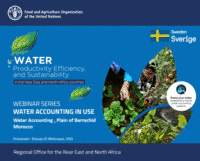
Webinar 10 Summary: Water Accounting, Plain of Berrechid Morocco
In this Webinar, Ehssan El Meknassi (FAO) delved into the context and challenges of water shortages in Morocco, indicating the objective of conducting/developing a Rapid Water Accounting (RWA) in the Berrechid plain, rapid water auditing and an action plan for the 2nd round of WA and auditing. The Berrechid plain suffers from overexploitation of the drinking and irrigation water supply leading to drying up of the water points. The methodological approach of the Berrechid RWA is given, followed by a description of the water resources, demands and uses in the Berrechid plain. Thereafter, a water balance analysis and fractional analysis of the consumption of the Berrechid plain are given followed by a Rapid Water Audit. One of the findings was that for the return flows, part of the water withdrawn from the source that is not consumed returned to its source or to another surface or ground water system. As such, a recommendation was given to carry more detailed water accounting, giving attention to water accounting plus and further need for capacity building.
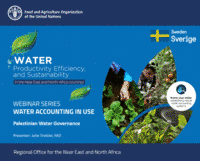
Webinar 11 Summary: Palestinian Water Governance
Julie Trottier (FAO) begins with the Oslo Agreement’s decisions on water management. Then, she presents the local water management of both surface and groundwater in the West Bank. The institutional trajectory of water is provided including the reasons why it is important as there are multiple water laws from different authorities operating in the same area. She explained pressures on water from different sources including licensed wells, unlicensed wells, and wastewater due to new irrigated area, and cautions that new development changes the institutional trajectory for water. Descriptions of various water development projects utilizing wastewater, licensed and unlicensed wells are provided, and she highlighted how they would affect existing water uses. She highlighted part of Kushner Plan related to agriculture and water and concluded with what can be done better to improve the Palestinian water situation.

Webinar 12 Summary: Can we count the water use of Nature? From catchment studies to environmental flows.
In this webinar, Vazken Andréassian (Directeur, Hydrology, Ecology and Water Quality research unit [HYCAR], INRAE) explores counting the water demand from nature. He introduced Turc-Mezentsev curve that estimates streamflow from the basin’s aridity index. He introduced paired catchment approach for forest hydrology experiments and shared some findings from USA and Australia. Mean, Median, and Low Flows peaked between 1970-75 for Australia and for the USA, Mean, Median, and Low Flows gradually decreased between 1970 till the most recent recording. Such experiments indicate the water use by vegetation upstream. . Thereafter, nature’s water demand in downstream is also investigated by providing explaining hydraulic-habitat and hydrological approaches to support Environmental flows determination. He explains that with these assessments, This is concluded with a series of answers to the questions of how much water should be left to Nature. There is no general rule on the determination of the environmental flow requirement, but it should be set with deep analysis of the ecosystem functions and priorities of the society.
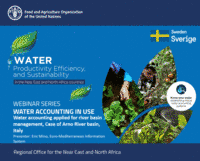
Webinar 13 Summary: Water accounting applied for river basin management, Case of Arno River basin, Italy
In this webinar, Eric Mino (Director of technical unit, Euro-Mediterranean Information System on know-how in the Water Sector) introduces water accounting in the European Union (EU) context by providing an overview on EU water policy and the focus of the EU on SEEA-W framework. This framework provides comprehensive, consistent and comparable policy relevant information. This is followed by a WA case study on the Arno River Basin, which has experienced severe droughts in several years since 2000. WA objectives are to improve the knowledge on water availability and its use, as well as support for decision making for the optimization of quantitative measures in the framework of river basin management plans. He presented water flow diagrams, data collection methods, processes of developing water accounts, and the process and results of scenario analysis on implementation of different sets of water saving measures. The challenges involved ecological flows were not integrated into SEEA_W, and difficulties in collecting socio-economic data at river basin level. S such, solutions were proposed to create indicator thresholds and collect desegregated data on water stress areas.
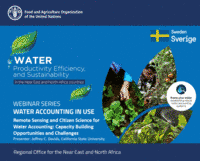
Webinar 14 Summary: Remote Sensing and Citizen Science for Water Accounting: Capacity Building Opportunities and Challenges
In this webinar, Jeffrey C. Davids (Assistant Professor, California State University, Chico) explains how non-traditional sources of data (e.g. citizen science) plays a key role in closing water accounting data gaps by pointing out the importance of citizen scientists as well as the importance of supporting innovative methods for measuring water flow by demonstrating examples of different tools. This is followed up with an explanation of the importance of water accounting capacity building efforts and how it must focus on training policy makers, water managers, and water educators to use open source data/tools/models supported by examples from Myanmar and Afghanistan. Last point explains the significance of remote sensing and modeling tools in improving the knowledge of where, when, and how much water is needed for a particular case. It was recommended that non-traditional sources of data can and should play a key role in closing WA data gaps. And finally, WA capacity building efforts should focus on training various stakeholders such as policy makers to use open source data/tools/models.
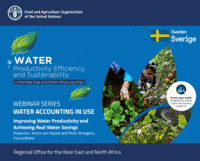
Webinar 15 Summary: Improving Water Productivity and Achieving Real Water Savings
In this webinar, Jonna van Opstal and Peter Droogers (FutureWater) gave a brief introduction on FutureWater and its role in the FAO Water Scarcity program for providing technical guidance for improving water productivity and training package for improving water productivity and achieving real water savings. The objectives of the program are to create clear & practical guideline to implementing water savings, and emphasizes the paradox between water savings at field and basin scale. , followed by a recap on the evolution of Irrigation solutions over 30 years. The outcomes of the Real Water Savings (REWAS) project such as providing guidance on crop water productivity are mentioned accompanied with the background information, and structure. An explanation of the beneficiaries from REWAS such as farmers and policy makers are given supported with a practical example from Iran. This is followed with an introduction to the REWAS tool and how it was used in Nepal and Iran. Finally, an overview of the REWAS training manual is provided.
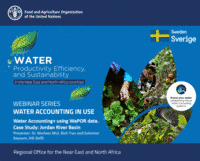
Webinar 16 Summary: Water Accounting+ (WA+) using WaPOR data. Case Study: Jordan River Basin (JBL)
In this webinar, Dr. Marloes Mul, Bich Tran and Solomon Seyoum (IHE Delft) introduce the concept of WA+, provide WaPOR-based Rapid Water Accounting for Jordan River Basin, and Water Balance outputs of Jordan river Basin from different Remote Sensing products. This was done by defining, explaining the components (geographical domain, accounting methods, data acquisition & analyses), and providing the framework evolution of water accounting. This is followed with the Rapid WA+ project overview of JRB that includes objectives, contents, analyses, and results. It was concluded that in the JRB, WaPOR datasets can provide a spatial overview of where in the basin water is generated and consumed via ET, water balance analysis showed a large discrepancy in total storage change estimated from WaPOR and NWC data from the GRACE TWSA solution, and significant water surplus at basin level for an arid condition. It was recommended to compare WaPOR with other P and ET products.
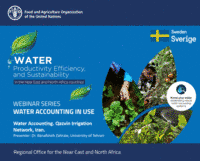
Webinar 17 Summary: Water Accounting. Qazvin Irrigation Network, Iran.
In this webinar, Dr. Banafsheh Zahraie (University of Tehran) introduces the Qazvin study area with characteristics such as history, location, area, climate and population. This was followed with an explanation and analysis of the climate variations and change over time with focus on precipitation change. A description of the surface water resources was given that comprised identifying the number of local rivers, and presenting findings of the annual streamflow for each. In addition, the water allocation from the Taleghan Dam was given followed by groundwater resource usage. The crop pattern schemes were explained including the method of surface water delivery to these crops. Water use both agricultural and domestic in the site was also explained, followed by a water balance summary. The webinar was finalized with proposed actions to reduce water accounting uncertainty estimations.

Webinars 18 Summary: Water Accounting for the Upper Litani Basin
In this webinar, Dr. Marloes Mul (IHE Delft) presents background information on the Litani River Basin such as main characteristics, challenges associated, the development plan, Water accounting plus outputs and who is interested in the information from the outputs. Bich Tran (IHE Delft) follows through with providing a focus on the Upper Basin. A water accounting analysis of the basin was given that involved monthly soil balance in a pixel based model, spatio-temporal variability of precipitation & evapotranspiration (ET), Pixel-to-point comparison with in situ measurements, Water generation & consumption, Basic water balance, Rainfall & incremental ET finalized with Irrigation water consumption in the Bekaa valley.
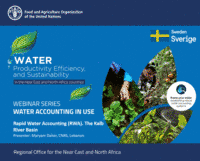
Webinar 19 Summary: Rapid Water Accounting (RWA). The Kalb River Basin
In this webinar, Maryam Daher (CNRS Lebanon) describes the RWA process by describing the characteristics of the study area such as land cover & use, why it was chosen and the field visits underwent. This is followed by a description of Water Balance Components & Processes in the Study area that includes precipitation, runoff, groundwater resources, hydrogeology, unconventional water, return flow, water import/export, and total water inflows. Infrastructure components such as surface storage facilities, irrigation & drainage schemes are identified. This is followed by results output of Water Demand, Use (and Access) and Consumption. The webinar concluded with facts and recommendations for the future.

Webinar 20 Summary: Water Accounting Plus (WA+) for Fayoum, Egypt
In this webinar, Naglaa Bendary (MWRI Egypt) provides an overview on Egypt’s national profile, MWRI’s importance of using WA+, and the principles of WA+. This is followed by an introduction to the study area that includes a data description of the site. A pre analysis of evapotranspiration from Lake Qaroun, urban areas and surrounding agricultural areas was presented followed by the water balance and WA+ results in the site. Limitations of the system and approach were pointed out and the webinar was finalized with recommendations for the future.
